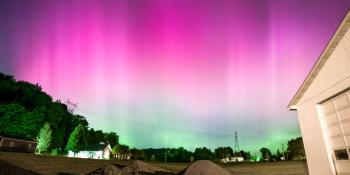Viewing archive of niedziela, 11 kwietnia 2010
Raport aktywności słonecznej
Any mentioned solar flare in this report has a scaling factor applied by the Space Weather Prediction Center (SWPC). Because of the SWPC scaling factor, solar flares are reported as 42% smaller than for the science quality data. The scaling factor has been removed from our archived solar flare data to reflect the true physical units.
Raport aktywności słoneczno- geomagnetycznej 2010 Apr 11 2201 UTCPrzygotowane przez NOAA © SWPC i przetworzone przez SpaceWeatherLive.com
Połączenie raportów USAF/NOAA o słonecznej i geofizycznej aktywności
Numer SDF 101 wydany w 2200Z na 11 Apr 2010IA. Analiza aktywności regionów słonecznych i aktywność od 10-2100Z do 11-2100Z Solar activity was very low. No flares occurred during
the past 24 hours. The solar disk was generally void of spots,
although there was some evidence late in the period for emerging
flux and possible new spot formation near S18E07.
IB. Prognoza aktywności słonecznej
Solar activity is expected to be very
low for the next three days (12-14 April).
IIA. Podsumowanie aktywności geofizycznej 10-2100Z do 11-2100Z
The geomagnetic field was initially quiet but became unsettled at
mid-latitudes and active with some isolated storm periods at high
latitudes after a sudden impulse at 1305Z (5 nT in Boulder). The
sudden impulse followed observation of a weak shock at the ACE
spacecraft at 1215Z; velocity jumped from 380 km/s to about 450
km/s, and the total magnetic field increased from 4 nT to about 10
nT. The shock was followed by moderately enhanced southward field Bz
with values ranging between -3 nT to -8 nT. The shock was most
likely a result of the halo CME that was observed on 08 April. The
greater than 2 MeV electron flux at geosynchronous orbit reached
very high levels.
IIB. Prognoza aktywności geofizycznej
The geomagnetic field is
expected to be quiet with some unsettled periods for the first day
(12 April) as the current disturbance subsides. Activity is expected
to be quiet for the second and third days (13-14 April).
III. Prawdopodobieństwa zdarzenia 12 Apr do 14 Apr
| Klasa M | 01% | 01% | 01% |
| Klasa X | 01% | 01% | 01% |
| Proton | 01% | 01% | 01% |
| PCAF | green | ||
IV. Przepływ 10,7 cm z Penticton
Zaobserwowano 11 Apr 075 Przewidywane 12 Apr-14 Apr 075/075/075 Średnia z 90 dni 11 Apr 083
V. Indeks geomagnetyczny A
Zaobserwowano Afr/Ap 10 Apr 003/003 Szacowane Afr/Ap 11 Apr 007/010 Przewidywane Afr/Ap 12 Apr-14 Apr 007/007-005/005-005/005
VI. Prawdopodobieństwa aktywności geomagnetycznej 12 Apr do 14 Apr
| A. Średnie szerokości geograficzne | |||
|---|---|---|---|
| Aktywne | 20% | 10% | 10% |
| Słaba burza | 05% | 01% | 01% |
| Bardzo znacząca burza | 01% | 01% | 01% |
| B. Wysokie szerokości geograficzne | |||
|---|---|---|---|
| Aktywne | 25% | 20% | 20% |
| Słaba burza | 15% | 10% | 10% |
| Bardzo znacząca burza | 05% | 01% | 01% |
All times in UTC
<< Idź do codziennego przeglądu
Najnowsze wiadomości
Najnowsze wiadomości z forum
AR3685 47May 2024 Geomagnetic Storms from AR 13664 (2) 323Anomaly.. 18Growth of Cycle 25 437Incoming Active Regions 367
Więcej tematówWesprzyj SpaceWeatherLive.com!
Wielu ludzi odwiedza SpaceWeatherLive aby śledzić aktywność słoneczną lub sprawdzić czy jest szansa na zaobserwowanie zorzy polarnej. Niestety, większy ruch na stronie oznacza większe koszty utrzymania serwera. Dlatego, jeśli jesteś zadowolony ze strony SpaceWeatherLive, zachęcamy do wspierania nas finansowo. Dzięki temu będziemy mogli utrzymać naszą stronę.

Fakty na temat pogody kosmicznej
| Ostatnie rozbłyski klasy X | 2024/05/15 | X2.9 |
| Ostatnie rozbłyski klasy M | 2024/05/17 | M7.1 |
| Ostatnia burza geomagnetyczna | 2024/05/17 | Kp6 (G2) |
| Spotless days | |
|---|---|
| Ostatni dzień bez skazy | 2022/06/08 |
| Monthly mean Sunspot Number | |
|---|---|
| kwietnia 2024 | 136.5 +31.6 |
| maja 2024 | 157.2 +20.7 |
| Last 30 days | 174.3 +64.2 |


